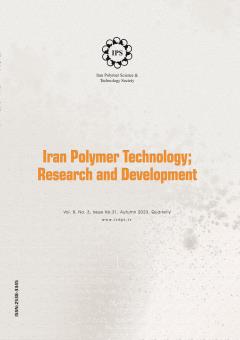A review of the use of rheology in the industry of producing propellants based on nitrocellulose polymer
Subject Areas :
1 -
Keywords: nitrocellulose, rheology, material functions, propellant, slip wall,
Abstract :
One of the main applications of nitrocellulose polymer is producing propellants. The propellant production process includes mixing nitrocellulose with solvents and other additives and converting it from a fibrous to a non-fibrous state during gelatinization and physical gel formation. This gel is subsequently subjected to shaping processes using ram or screw extrusion. One of the main problems in producing propellant based on nitrocellulose is the lack of uniformity and product quality control. Despite the high capability of rheology knowledge as a powerful tool for measuring the quality control of raw materials and the production process of propellant based on nitrocellulose, this knowledge has received less attention from researchers and manufacturers in this field. This article reviewed the use of rheology in different parts of the production of nitrocellulose-based propellants, from the quality control of the incoming raw materials to the final mixing and extrusion. At first, the rheological behavior of nitrocellulose mixtures was discussed. Next, the effect of nitrocellulose polymer microstructure on the rheological behavior of its solution was discussed. Phenomena affecting the measurement of the rheological behavior of the mixture, such as wall slippage, were among the other cases investigated. Finally, a review of the quality control methods of nitrocellulose-based propellant products using appropriate material functions and production process modification was discussed.
1. Golubev A.Neshitova A.Singin P.Kuvshinova S.Burmistrov V.,Koifman O., Plasticization of Cellulose Nitrate by 4-Nitrophtalic Acid Esters, Russian Journal of General Chemistry, 87, 3086-3092, 2017.
2. Kim S.T.Lim J.Y.Choi H.J.,Hyun H., Solution Characteristics of Nitrocellulose, Journal of Industrial and Engineering Chemistry, 12(1), 161-164, 2006.
3. Kotter L.N. ,Groven L.J., Hansen Solubility Parameters of Nitrocellulose and Application toward Printable Energetics, Langmuir, 38(29), 8766-8772, 2022.
4. Mattar H.Baz Z.Saleh A.Shalaby A.Azzazy A.E.Salah H.,Ismail I., Nitrocellulose: Structure, Synthesis, Characterization, and Applications, Water Energy Food Environ. J, 3, 1-15, 2020.
5. Sule R.Rivera G.,Gomes A.V., Western Blotting (Immunoblotting): History, Theory, Uses, Protocol and Problems, BioTechniques, (0), 2023.
6. Fernández J.G.Almeida C.A.Fernández-Baldo M.A.Felici E.Raba J.,Sanz M.I., Development of Nitrocellulose Membrane Filters Impregnated with Different Biosynthesized Silver Nanoparticles Applied to Water Purification, Talanta, 146, 237-243, 2016.
7. Kuracina R.Szabová Z.Kosár L.,Sahul M., Study into Influence of Different Types of Igniters on the Explosion Parameters of Dispersed Nitrocellulose Powder, Journal of Loss Prevention in the Process Industries, 83, 105017, 2023.
8. Frem D., A Reliable Method for Predicting the Specific Impulse of Chemical Propellants, Journal of Aerospace Technology and Management, 10, 2018.
9. Carter R. ,Warren R., Extrusion Stresses, Die Swell, and Viscous Heating Effects in Double‐Base Propellants, Journal of Rheology, 31(2), 151-173, 1987.
10. Bobić N.Totovski L.Jelisavac L.Nikolić J.Bošnjakov M.R.Marković S.,Drmanić S., The Gelatinization of Nitrocellulose by Primary Stabilizers, Advanced Technologies, 6(2), 31-37, 2017.
11. Warren R., The Effect of Ageing and Annealing on the Physical Properties of Nitrocellulose Plasticized with Nitroglycerine, Polymer, 31(5), 861-868, 1990.
12. Martínez-Pastor J.Franco P.Moratilla D.,Lopez-Garcia P.J., Optimization of Forming Processes for Gelled Propellant Manufacturing, Modeling and Simulation in Industrial Engineering, 1-28, 2018.
13. Warren R.C., Basic Rheology and Its Application to Nitrocellulose Propellant Processing by Screw Mix-Extruders. 1990: Department of Defence, Defence Science and Technology Organisation.
14. Dombe G.Mehilal D.Bhongale C.Singh P.P.,Bhattacharya B., Application of Twin Screw Extrusion for Continuous Processing of Energetic Materials, Central European Journal of Energetic Materials, 12(3), 507-522, 2015.
15. Hu Q.Gu H.Zhang H.Li C.Ying S.,Xiao Z., Comparative Study on the Rheological Properties of Cellulose Acetate and Double‐Base Propellant, Propellants, Explosives, Pyrotechnics, e202300071.
16. Birinci E.Gevgilili H.Kalyon D.M.Greenberg B.Fair D.F.,Perich A., Rheological Characterization of Nitrocellulose Gels, Journal of Energetic Materials, 24(3), 247-269, 2006.
17. Solovov R.Kazberova A.,Ershov B., Special Aspects of Nitrocellulose Molar Mass Determination by Dynamic Light Scattering, Polymers, 15(2), 263, 2023.
18. Baker F.Healey M.,Privett G., The Rheological Properties of Plasticized Nitrocellulose as a Function of Nitrocellulose Precursor, Propellants, Explosives, Pyrotechnics, 13(4), 99-102, 1988.
19. Warren R., The Effect of Liquid Crystal Structure on the Rheological Properties of Nitrocellulose-Dimethylacetamide Solutions, Rheologica acta, 23, 544-547, 1984.
20. Baker F.Carter R.,Warren R., The Rheological Assessment of Propellants, in Rheology: Volume 3: Applications. 1980, Springer. p. 591-596.
21. Mao C.F. ,Chen C.H., Thermoreversible Gelation of Nitrocellulose Solutions, Journal of Applied Polymer Science, 90(14), 4000-4008, 2003.
22. Martinez-Pastor J.Franco P.,Ramirez-Fernandez F.J. Rheological Characterization of Energetic Materials by Rotational Testing Techniques. in Engineering Systems Design and Analysis. 2014. American Society of Mechanical Engineers.
23. Chin R.J.Lai S.H.Ibrahim S.,Wan Jaafar W.Z., Factors Affect Wall Slip: Particle Size, Concentration, and Temperature, Applied Rheology, 28(1), 201815775, 2018.
24. Kalyon D.M., An Overview of the Rheological Behavior and Characterization of Energetic Formulations: Ramifications on Safety and Product Quality, Journal of Energetic Materials, 24(3), 213-245, 2006.
25. Martinez-Pastor J.Franco P.Ramirez F.,Lopez-Garcia P., Experimental Analysis of Rheological Behaviour of a Multi-Base Energetic Material During Non-Continuous Mixing, Procedia engineering, 132, 366-372, 2015.
26. Martinez-Pastor J.Franco P.,Franco-Menchon J., Optimization of Extrusion Process of Double-Base Propellants from Their Rheological Properties, International Journal of Material Forming, 12, 307-320, 2019.
27. Martinez-Pastor J.Franco P.Ramirez F.,Lopez-Garcia P., Experimental Analysis of Rheological Behaviour of a Multi-Base Energetic Material During Conventional Extrusion, Procedia Engineering, 132, 373-380, 2015.
28. Martinez-Pastor J.Franco P.Ramirez F.J.,Lopez-Garcia P.J., Influence of Rheological Behaviour on Extrusion Parameters During Non-Continuous Extrusion of Multi-Base Propellants, International Journal of Material Forming, 11, 87-99, 2018.


